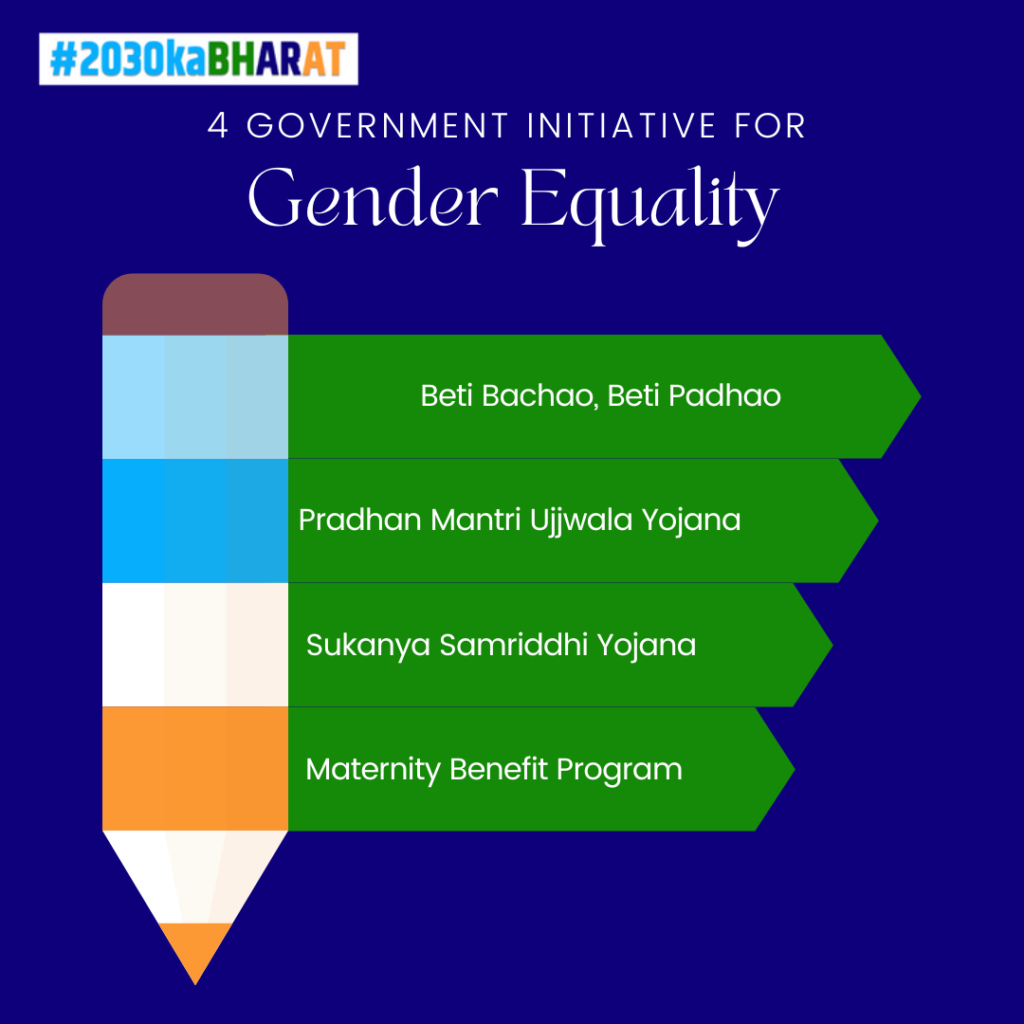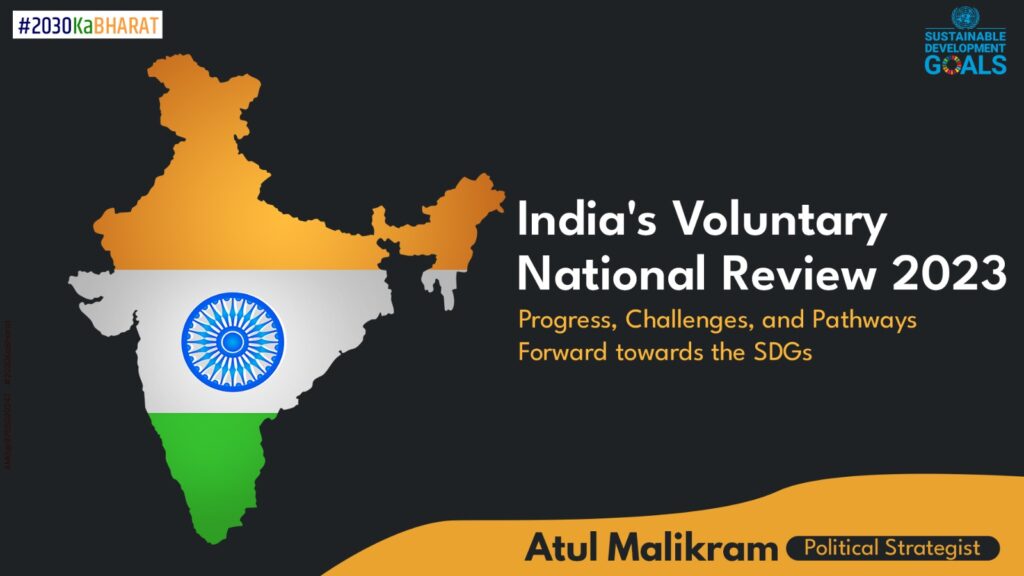In September 2023, India presented its second Voluntary National Review (VNR) at the United Nations High-Level Political Forum (HLPF), offering a critical self-assessment of its progress towards the Sustainable Development Goals (SDGs). Adopted globally in 2015, the 17 SDGs and their 169 targets represent a blueprint for a just, equitable, and sustainable future for all. Examining India’s VNR 2023 necessitates exploring both accomplishments and roadblocks, offering a vital roadmap for accelerating the country’s SDG journey.
Shining Lights: Notable Gains across Key Goals
India’s Voluntary National Review 2023 highlighted significant advancements in several crucial SDGs. One noteworthy success story lies in SDG 1: No Poverty. India’s multi-pronged approach, encompassing targeted social safety nets like PM-Kisan Samman Nidhi and Pradhan Mantri Jan Dhan Yojana, has yielded measurable results. According to the World Bank, extreme poverty in India declined from 21.9% in 2015 to 5.8% in 2019, representing a remarkable 16-point drop. Further, literacy rates witnessed a steady rise, exceeding 77% in 2020, showcasing progress towards SDG 4: Quality Education.
On the SDG 6: Clean Water and Sanitation front, India has made strides in rural sanitation coverage, achieving over 99% under the Swachh Bharat Abhiyan mission. Additionally, schemes like Jal Jeevan Mission aim to provide piped water access to every household by 2024, demonstrating India’s commitment to water security.
Recognizing the crucial role of affordable and clean energy in sustainable development, India has embarked on an ambitious renewable energy expansion plan. By 2023, India had already surpassed its initial target of 175 GW of renewable energy capacity and is now aiming for 500 GW by 2030, aligning with SDG 7: Affordable and Clean Energy. These initiatives signify India’s potential to become a global leader in green energy transition.
Emerging Shadows: Persistent Challenges on the Road to Sustainability
While India’s Voluntary National Review 2023 proudly showcased progress, persistent challenges threaten to impede its path towards achieving the SDGs. One concerning aspect is the widening inequality gap, highlighted by the 2022 World Inequality Report, which states that India has the highest level of inequality among BRICS nations. This uneven distribution of wealth and opportunities undermines progress towards SDG 10: Reduced Inequalities.
The ongoing COVID-19 pandemic exposed vulnerabilities within India’s healthcare system, particularly in rural areas. Strengthening and expanding accessible healthcare infrastructure remains crucial to achieve SDG 3: Good Health and Well-being. Additionally, ensuring gender equality and eliminating all forms of discrimination against women and girls, as envisioned by SDG 5: Gender Equality, needs sustained efforts to address issues like child marriage and limited access to education and economic opportunities.
Climate change presents an existential threat to India’s sustainable development, demanding urgent action. While India’s commitment to renewable energy is commendable, achieving SDG 13: Climate Action necessitates further initiatives to curb greenhouse gas emissions and adapt to the impacts of climate change, particularly in vulnerable coastal and agrarian regions.
Charting the Course: Recommendations for a Sustainable Future
To expedite India’s SDG journey, several key recommendations emerge from the Voluntary National Review 2023 analysis. Firstly, fostering inclusive growth through targeted policies and programs aimed at bridging the inequality gap is essential. This could involve strengthening social safety nets, promoting small and medium-sized enterprises, and investing in skill development for marginalized communities.
Secondly, continuously strengthening healthcare infrastructure, particularly in rural areas, and ensuring access to quality healthcare for all are critical to achieve SDG 3. This implies increased public investment in healthcare facilities, personnel, and essential medical supplies.
Thirdly, promoting gender equality requires comprehensive legal and policy frameworks coupled with social awareness campaigns. Investing in girls’ education, ensuring economic empowerment of women, and addressing all forms of gender-based violence are fundamental steps towards SDG 5.
Fourthly, accelerating the transition to a low-carbon economy through increased investments in renewable energy, sustainable infrastructure development, and adoption of climate-smart practices in agriculture and industry are crucial for combatting climate change and attaining SDG 13.
Finally, fostering strong multi-stakeholder partnerships involving government, civil society, academia, and the private sector is crucial for resource mobilization and collaborative action towards achieving the SDGs. Engaging local communities and incorporating their knowledge and perspectives in policy decisions further strengthens the ownership and sustainability of development efforts.
India’s Voluntary National Review 2023 presents a nuanced picture of a nation striving towards a brighter future. While significant progress has been made in several SDGs, including poverty reduction, sanitation, and renewable energy, critical challenges remain, particularly in areas like inequality, healthcare, gender equality, and climate change. Overcoming these obstacles requires renewed commitment and concerted action from all stakeholders.
Case Studies to Illustrate Progress and Challenges in India’s SDG Journey
To complement the analysis and recommendations presented above, let’s dive into specific case studies showcasing both noteworthy achievements and persistent challenges hindering India’s SDG progress:
Case Study 1: Reducing Poverty through Microfinance – SDG 1: No Poverty
- Challenge: High levels of poverty, particularly in rural areas, with 21.9% of the population living below the national poverty line in 2015.
- Solution: The Pradhan Mantri Mudra Yojana (PMMY) scheme provides microloans to entrepreneurs and small businesses, empowering them to generate income and break the cycle of poverty.
- Impact: Over 364 million loans have been disbursed under PMMY since 2015, leading to the creation of millions of jobs and contributing to a significant reduction in poverty rates. According to the World Bank, extreme poverty in India declined to 5.8% in 2019.
Lessons Learned:
- Microfinance programs can be a powerful tool for poverty reduction if they are designed effectively and reach the most vulnerable populations.
- Building financial literacy and providing support services alongside loans are crucial for sustainable success.
Challenges Remaining:
- Ensuring equitable access to microfinance for women, marginalized communities, and geographically remote areas.
- Addressing debt burdens and potential exploitative practices by some lenders.
Case Study 2: Swachh Bharat Abhiyan – A Triumph in Sanitation – SDG 6: Clean Water and Sanitation
- Challenge: Open defecation and poor sanitation infrastructure posed major health risks and environmental hazards, with only 49% of rural households having access to toilets in 2014.
- Solution: The Swachh Bharat Abhiyan (Clean India Mission) launched a nationwide campaign to promote toilet construction and eliminate open defecation.
- Impact: Within six years, India achieved nearly 100% rural sanitation coverage, surpassing its initial target. This remarkable improvement translated into significant health benefits and prevented countless deaths from preventable diseases.
Lessons Learned:
- Community-led awareness campaigns coupled with behavior change initiatives can drive social transformation.
- Government commitment and resource allocation are critical for achieving large-scale sanitation goals.
Challenges Remaining:
- Ensuring proper use and maintenance of toilets, particularly in underserved communities.
- Addressing sanitation challenges in urban areas, including slum settlements and informal settlements.

Case Study 3: The Fight for Gender Equality – Addressing Persistent Gaps in SDG 5:
- Challenge: India fares poorly in global gender equality rankings, with significant disparities in education, economic opportunities, and political participation.
- Solution: Initiatives like the Beti Bachao Beti Padhao (Save Girl Child, Educate Girl Child) scheme aim to improve girls’ education and empowerment.
- Impact: India has witnessed a rise in girls’ enrollment in primary and secondary education. However, challenges remain in higher education and ensuring fair access to jobs and leadership positions.
Lessons Learned:
- Investing in girls’ education is critical for unlocking their full potential and driving national development.
- Legal frameworks and affirmative action policies can help promote gender equality in various spheres.
Challenges Remaining:
- Combating deep-rooted social and cultural biases against girls and women.
- Addressing domestic violence and sexual harassment.
- Ensuring equal pay and representation of women in the workforce and government.
These case studies offer a glimpse into both the inspiring advancements and the persistent challenges India faces in its quest for the SDGs. By learning from successes, actively addressing existing roadblocks, and fostering collaborative action, India can continue its journey towards a more equitable and sustainable future for all.

Recommendations for the Future:
- Deepen the Focus on Inclusivity: Bridge the inequality gap through targeted social safety nets, promoting small businesses, and investing in skill development for marginalized communities.
- Strengthen Healthcare Systems: Expand healthcare infrastructure and personnel, prioritizing rural areas and ensuring accessible quality healthcare for all.
- Champion Gender Equality: Enact robust legal frameworks, implement social awareness campaigns, and invest in girls’ education and women’s economic empowerment.
- Combat Climate Change: Accelerate the transition to clean energy, promote sustainable infrastructure, and adopt climate-smart practices in agriculture and industry.
- Embrace Multi-Stakeholder Partnerships: Forge collaborative partnerships between government, civil society, academia, and the private sector for resource mobilization and joint action.
- Empower Local Communities: Engage local communities in decision-making processes, incorporating their knowledge and perspectives for sustainable development.
These recommendations serve as a roadmap for navigating the remaining distance towards the 2030 Agenda. India’s Voluntary National Review 2023 offers a valuable self-assessment, illuminating both achievements and obstacles. Embracing the spirit of “Sabka Saath, Sabka Vikas” (Collective Efforts, Inclusive Growth), India can emerge as a beacon of hope, demonstrating that sustainable and equitable development is not just a dream, but a tangible reality within reach.
Looking Beyond 2030:
While the 2030 Agenda serves as a vital framework, it’s crucial to recognize that its goals represent a stepping stone, not the ultimate destination. As India strides towards the 2030 horizon, it must keep its gaze fixed on a future beyond, one where sustainability and equity are deeply embedded in its socio-economic fabric. This implies continuously revising and refining development strategies, embracing innovation and disruptive technologies, and fostering a culture of lifelong learning and adaptability.
India’s future is intrinsically linked to the well-being of the planet and its diverse inhabitants. Honoring the spirit of the SDGs necessitates not just achieving these goals within its own borders, but also actively contributing to global solutions for interconnected challenges like climate change, pandemics, and inequality. By sharing its successes, lessons learned, and challenges with other nations, India can become a catalyst for collective action and progress towards a shared, sustainable future for all.
In conclusion, India’s Voluntary National Review 2023 paints a picture of a nation on the move, embracing the SDGs as a guiding light to illuminate its path towards a more just, equitable, and sustainable future. By acknowledging the remaining challenges, committing to bold actions, and fostering meaningful partnerships, India can not only achieve its own SDG goals but also inspire others to embark on a similar journey, transforming the world into a place where the promise of the 2030 Agenda becomes a lived reality.
References for Data Used in the Article:
India’s VNR 2023:
World Bank Poverty Data:
Literacy Rates in India:
Rural Sanitation Coverage in India:
India’s Renewable Energy Capacity:
World Inequality Report 2022:
Climate Change and India:
Case Studies:
- SDG 1: No Poverty:
- Pradhan Mantri Mudra Yojana: https://www.mudra.org.in/
- World Bank Poverty Data: https://data.worldbank.org/topic/poverty
- SDG 6: Clean Water and Sanitation:
- Swachh Bharat Abhiyan: https://swachhbharatmission.gov.in/
- World Health Organization: https://www.who.int/teams/environment-climate-change-and-health/water-sanitation-and-health
- SDG 5: Gender Equality:
- Beti Bachao Beti Padhao: https://wcd.nic.in/schemes/beti-bachao-beti-padhao-scheme
- World Economic Forum Gender Gap Report: https://www.weforum.org/publications/global-gender-gap-report-2022/
